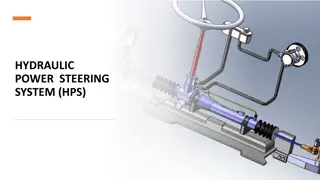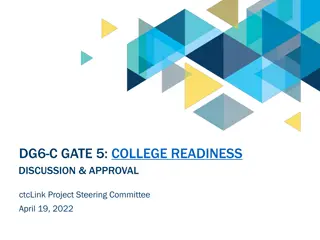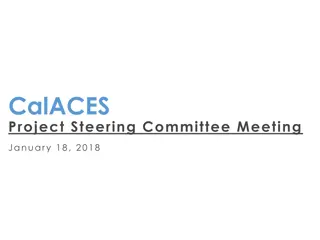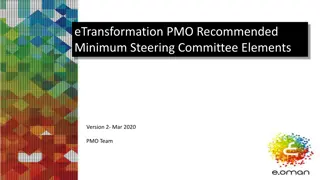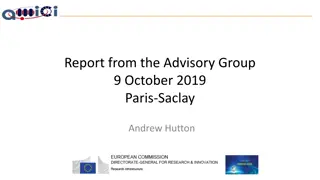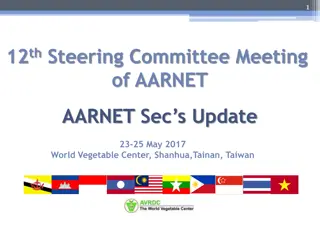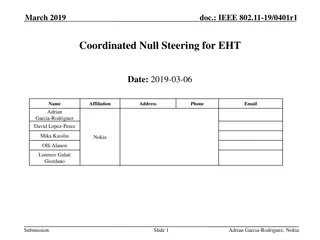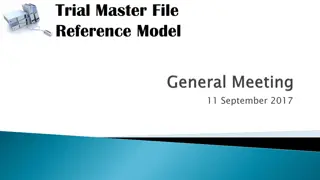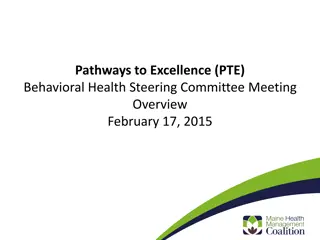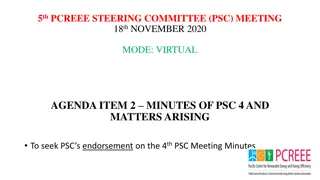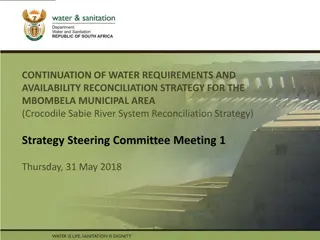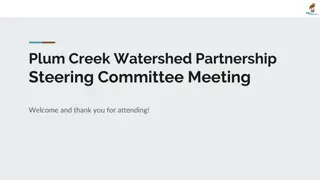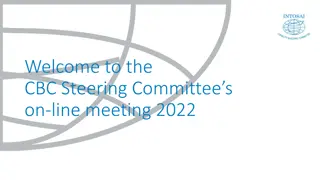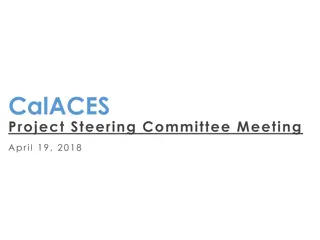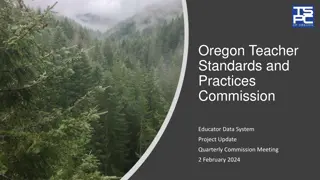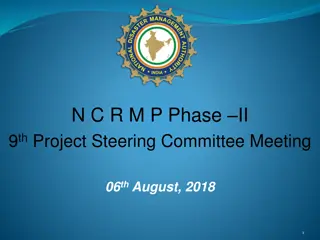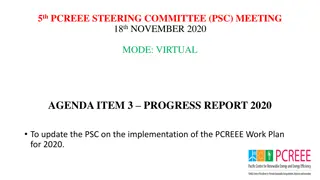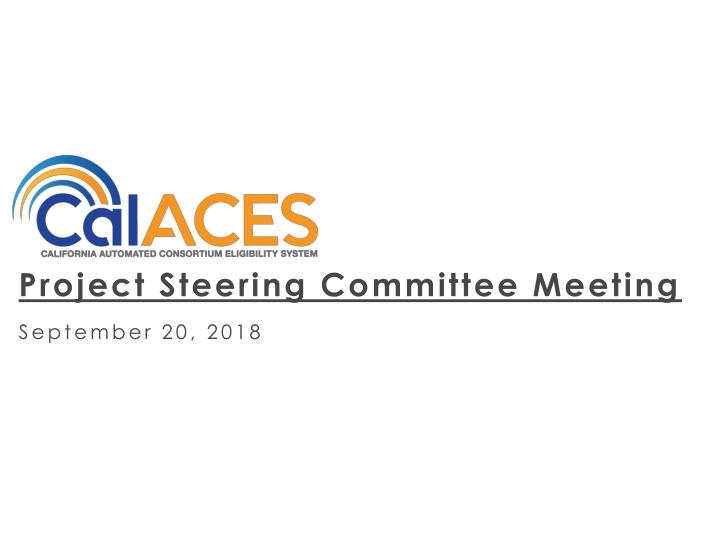
Project Steering Committee Meeting - September 20, 2018
Project Steering Committee had a meeting on September 20, 2018 to review the agenda, approve previous meeting minutes, and discuss CalACES/CalSAWS negotiations with Accenture. The meeting also involved contract negotiations for CalSAWS DD&I framework and Accenture deferred items not included in the scope or price.
Download Presentation

Please find below an Image/Link to download the presentation.
The content on the website is provided AS IS for your information and personal use only. It may not be sold, licensed, or shared on other websites without obtaining consent from the author. If you encounter any issues during the download, it is possible that the publisher has removed the file from their server.
You are allowed to download the files provided on this website for personal or commercial use, subject to the condition that they are used lawfully. All files are the property of their respective owners.
The content on the website is provided AS IS for your information and personal use only. It may not be sold, licensed, or shared on other websites without obtaining consent from the author.
E N D
Presentation Transcript
Project Steering Committee Meeting September 20, 2018
CalACES PSC Agenda 1) Call Meeting to Order 2) Agenda Review 3) Public opportunity to speak on items not on the Agenda 2
CalACES PSC Action Items 4) Approve the Minutes of the July 19, 2018 Project Steering Committee Meeting and review of Action Items 3
Update on CalACES/CalSAWS Discussions with Accenture
CalSAWS DD&I Contract Negotiations Framework and Results CalSAWS When: August 2: Accenture Change Order and Initial Cost Proposal submitted August 3: Provide Final DD&I Requirements (including CalWIN ancillary systems) August 6 September 5: Conduct business negotiations August 15: Accenture Revised Change Order and Cost Proposal submitted August 29: Accenture Revised Change Order and Cost Proposal submitted August 31: DXC preliminary conversion Cost Proposal submitted September 4: Accenture Revised Change Order and Cost Proposal submitted September 5: Meeting with CalACES and Accenture Legal Counsel September 6 18: Legal Counsel to prepare Amendment that represents the business deal September 19-20: Final review and revisions to Change Order and Amendment September 21: Submit Change Order and Contract Amendment to OSI with IAPD
Accenture Deferred Items Not included in September 4 Scope or Price CalSAWS Scope Item Status Description The effort to implement the State Forms and associated translations will be completed by the Consortium via use of M&O Funds. The effort to implement the State Notices of Action and associated translations will be completed by the Consortium via use of M&O Funds. 1 State Forms Removed 2 NOAs Removed Functional Design Sessions will result in finalized requirement(s) and effort for Non-State Forms. Functional Design Sessions will focus for consolidating similar non-State forms across the 58 counties. Functional Design Sessions will result in finalized requirement(s) and effort for Task Management. Functional Design Sessions will result in finalized requirement(s) and effort for the following APIs: Lobby Management Employment Support Services Master Data Management GA/GR Language removed from requirement Functional Design Sessions will result in finalized requirement(s) and effort for GA/GR. Functional Design Sessions will result in finalized requirement(s) and effort. Pending further Consortium/County discussions on approach. Functional Design Sessions will result in finalized list of systems, requirement(s) and effort for Ancillary System Conversion. 3 Non-State Forms Deferred 4 Task Management Deferred APIs (Application Programming Interface) 5 Deferred 6 GA/GR Deferred 7 Imaging 8 Call Center Ancillary System Conversion Deferred Deferred 9 Deferred
CalSAWS DD&I Contract Negotiations Framework CalSAWS Key Assumptions about the Scope of Work: Assuming a deal for CalSAWS Migration DD&I can be reached, requirements and deliverables associated with technical infrastructure, cloud, operations and SLAs will be defined as part of the Change Order/Amendment resulting from the LRS Cloud Proof of Concept (POC) CalWIN Training, Change Management and Implementation Support tasks and deliverables are not included in this scope of work Portal and Mobile App are not included in this scope of work
CalSAWS DD&I Contract Negotiations Framework CalSAWS What: Scope: CalSAWS Design, Development and Test CalACES Implementation, Training and Organizational Change Management Assumed start date: Monday, January 7, 2019 Contract Requirements: Amend the LRS Agreement Accenture is directed to propose and price to the existing LRS Terms and Conditions If a deal is reached, requirements and deliverables associated with technical infrastructure, cloud, operations and SLAs will be defined as part of the Change Order/Amendment resulting from the LRS Cloud POC The C-IV M&O contract extension will be handled separately Still ambiguity in requirements so Accenture was directed to document assumptions in SOW and cost proposal
CalACES PSC Pre-Consolidation Governance Workgroup ( little g ) Update Workgroup Objective This cross consortia group, made up of deputies from the three SAWS are developing documentation to assist with the transition of adding CalWIN counties into the committee governance structure, to allow for 58-county (6 Regions) input into SCR designs. To date, this workgroup is working to develop draft: 1) Guiding Principles for CalSAWS Committees 2) Regional Manager Roles and Responsibilities 3) Proposed Committees 4) Cross Walk CalWIN and CalACES Change Governance 5) 2019 Side-by-Side Release Schedules More to come at the Strategic Conference! 10
Ancillary Systems Revised Approach Based on Contract Negotiations 11
Ancillary Systems Decision Making Process CalSAWS Review Major Topic Areas Imaging Appointment Management Lobby Management Task Management Call Center Three-pronged Approach White Papers Webinar Demonstrations Functional Designs with Accenture
Ancillary Systems: White Papers CalSAWS White Paper Documentation for: Imaging Call Center Task Management (Draft) White Papers include: Overview of current state Relevant Facts Alternatives Analysis by McKinsey Pros and Cons of each alternative Key Issues for Considerations Appendices with cost details
Ancillary Systems CalSAWS Approach to Webinar Demonstrations: Demonstrate LRS as-is whenever possible Demonstrate/provide an overview of functionality captured in the requirements from CalWIN County visits Joint county/consortium approach LRS as-is will be presented by Consortium/County staff Complex ancillary requirements will be presented by individual counties, as needed Review requirements from CalWIN county visits to obtain county input Webinar schedule will be distributed via CIT to all counties Number of attendees is county determined number of call-in lines per county limited to 3
Ancillary Systems: Modifications to Approach CalSAWS Original Approach from McKinsey White Paper: Sessions (Webinar Demonstrations) will be held to demonstrate the target state solution, explain and discuss requirements, and to validate the requirements for enhancement. Webinar Demonstrations will promote education and understanding Functional Design Sessions from January April 2019 will be used to finalize requirements Accenture will lead functional design sessions with the 58 Counties to finalize requirements for the following topics: Imaging Task Management Non-State Forms APIs for Lobby Management, Employment Services and Master Data set Conversion needs for CalWIN Ancillaries GA/GR
Ancillary Systems: Contact Center/HD Approach CalSAWS Conduct Contact Center/HD Webinar as planned AND conduct requirements gathering sessions that will feed an IAPDU and resulting procurement Considerations: The Call Center component of the Accenture agreement has been removed as it was cost prohibitive McKinsey is re-evaluating the current recommendation in Deliverable 10 Recommendation Competitively procure a Call Center software package for the California Counties
Ancillary Systems: Next Steps CalSAWS Schedule Webinar Demonstrations: Plan for Early October for the first session Recommended schedule: Begin Early October with Imaging Follow in two/three week increments with: Task Management Appointment Management Lobby Management Call Center Send corresponding White Papers 2 weeks prior to Webinar Demonstration Feedback from these demonstrations will be captured and provided to CalSAWS leadership for review and further decision making
Review Status of the LRS Cloud Proof of Concept
CalACES PSC CalSAWS Stakeholder Engagement Process AB 1811 Human Service Omnibus Chapter 35, Section 15-17 Bill Language SECTION15 1) The Legislature finds and declares all of the following: 2) (a) Through the Statewide Automated Welfare System (SAWS) consortia, the state and counties provide health and human services to over 13 million Californians. 3) (b) The state is currently working in partnership with the federal government to consolidate the existing consortia systems and functionality into one single California Statewide Automated Welfare System (CalSAWS). This consolidation will heavily leverage the existing Los Angeles Eligibility, Automated Determination, Evaluation, and Reporting (LEADER) Replacement System, rather than building a new system. 4) (c) California, its counties, and stakeholders have a decades-long partnership and commitment to excellence in service delivery for its health and human services programs. This partnership is a relationship built on effective communication, transparency, and a shared vision of service to millions of low- income and vulnerable Californians. 5) (d) The CalSAWS will be the primary automation system for delivering benefits for several decades. 6) (e) The CalSAWS development process will be improved through meaningful stakeholder, client, and advocate input on elements that impact service delivery. 21
CalACES PSC CalSAWS Stakeholder Engagement Process SECTION 16. Section 10823.1 is added to the Welfare and Institutions Code, to read: 10823.1. 1) (a) It is the intent of the Legislature that representatives from the State Department of Social Services, the State Department of Health Care Services, the Office of Systems Integration, the SAWS consortia, and the counties meet with advocates, clients, and other stakeholders no less than quarterly to review the development status of the California Automated Consortium Eligibility System (CalACES) and the California Statewide Automated Welfare System (CalSAWS) projects. 2) (b) Meeting agendas shall be established based on input from all parties, who may indicate their priorities for discussion. 3) (c) The State Department of Social Services, the State Department of Health Care Services, the Office of Systems Integration, and the SAWS consortia shall engage with stakeholders to discuss current and planned functionality changes, system demonstrations of public portals and mobile applications, and advocates identification of areas of concern, especially with the design of public-facing elements and other areas that directly impact clients. 4) (d) These meetings shall commence in the summer of 2018 and shall continue at least quarterly through development, implementation, and maintenance. 22
CalACES PSC CalSAWS Stakeholder Engagement Process SECTION 17. Section 10823.2 is added to the Welfare and Institutions Code, to read: 10823.2. 1) (a) The State Department of Social Services, the State Department of Health Care Services, and the Office of Systems Integration shall develop, in consultation with the County Welfare Directors Association of California, the SAWS consortia, and stakeholders, a formal process for health and human services advocates and clients to provide input into new or changing public facing elements of CalACES and CalSAWS. 2) (b) The process described in subdivision (a) shall include public portals, mobile applications, notices, certain ancillary services, and intercounty transfers. 3) (c) The process described in subdivision (a) may include focus groups, user- centered design sessions, and user acceptance testing. 23
CalACES PSC CalSAWS Stakeholder Engagement Process CalSAWS Stakeholder Engagement Kickoff Meeting September 12 Agenda Topics: Background/History Federal Communications/Expectations Update on 2018 CalSAWS Planning Activities and Schedule Upcoming Procurements associated with client facing elements and opportunities for stakeholder involvement SAWS Key Initiatives Advocate Areas of Interest - Open Discussion Debrief of the Meeting Next Steps 24
Status of PSC Priorities CalFresh QC Error Rate Disaster CalFresh (DCF) Change Management Reports Customer Facing Technology
CalACES PSC CalFresh (CF) QC Error Rate Key Objective from 7/19 PSC meeting: Analyze errors across the state the affect CF QC error rate and identify solutions. Status: In progress CalACES has been working on the following SCRS to help counties mitigate QC errors. Findings: TBD Action Plan: TBD 26
CalACES PSC Change Management Key objectives from 7/19 PSC Meeting Develop a weighted scale to determine if an SCR requires additional implementation and/or post implementation support. Provide counties with standardized guidance on implementing new functionality on a scalable level (i.e. Release Note Quick Card). Educate counties on release opportunities to test upcoming changes. Explore ways to implement policy expediently, upon final release of State guidance where there is a short turnaround for implementation. Status: In Progress Current practice with SCR design is to work with committee on determining outreach activities. Based on county input RMs have worked with Project staff to further define and enhance the change management process to address the needs of counties. RMs have been attending facilitator meetings to ensure that there is a consistency of messaging regarding the current change management process. RMs have reminded counties of the opportunity to request demos of functionality changes at the Release Webcasts held two weeks prior to each Release 27
CalACES PSC Reports Key Objectives from 7/19 PSC meeting: Prioritize existing Report(s) SCRs Create new dashboards or reports that will assist managers to manage units. Implement subscription reports in CalACES, with the ability for Directors/Deputy Directors to access the reports remote (i.e. phone, tablet). Ensure staff are educated where data in C-IV/CalACES Oracle Business Intelligence reporting tool (OBIEE) is being pulled/calculated from. Status: In Progress The Reports committee will be prioritizing the current Report SCRs. The RMs have reached out to their counties and requested they log tickets for reports perceived as having incorrect data or have noticeable performance issues. We have also requested they submit an enhancement request for any report(s) they need to support their business processes. Region 8 is convening a workgroup to discuss issues with existing reports. Work with RMs to help counties identify where the gaps in understanding of reports and/or report data resides. Subscription Reports are pending further discussion. 28
CalACES PSC Customer Facing Technology Key objectives from 7/19 PSC meeting: Ability to quickly inform customers via email/text regarding emergencies Staff need to understand the self-service portal Develop marketing methods for self-service technology Obtain online/phone support for self-service portal Simplify customer login/opt-in process Status: In Progress SCRs have been created in C-IV and/or CalACES for the following objectives: SCR CA-204664 - Simplify Customer log/opt in process(es) SCR C-IV-102240 - Ability to quickly inform customers via text/email campaigns about emergencies or other critical information. The Project will work with the RMs regarding the identification and development of a marketing approach for the existing applications, as well as an approach to quickly inform customers when necessary. The self-service portal will be a competitive procurement where application support and the sandbox for staff will be addressed. 29
CalACES PSC Disaster CalFresh (DCF) Status Key Objectives from the 7/19 PSC meeting: Automate DCF in the CalACES System. Implement the CF 385 in the CalACES System. Update DCF Reporting in the C-IV and CalACES System. Status: In Progress A proposal for automating and updating several Disaster CalFresh (DCF) has been submitted to CWDA for consideration for legislative and budget priorities for 2019. Proposals will be reviewed by the legislative committee in the fall and finalized by the Board of Directors in December. Changes requested in the proposal are: Add cross county login ability Update DCF Mass Replacement batch job Add the CF 385 DCF Application questions to CalACES and automate eligibility rules Add Daily DCF Report Automate DCF NOAs 30
CalACES PSC SCR Planning Group Updates CalACES SPG Approved SCRS R18.09 Design Confirmed As of 09/06/2018 SOUTH: 89 SCRS 15 Critical SPG Items NORTH: 37 SCRS 7 Critical SPG Items 32
CalACES PSC SCR Planning Group Updates CalACES North Backlog as of 09/06/2018 33
CalACES PSC SCR Planning Group Updates CalACES South Backlog as of 09/06/2018 34
Please turn to the handout titled 10-1 CalACES SCR Process v10 PSC 20180920.pptx 35
Background CalACES PSC The C-IV system and the Leader Replacement System (LRS) continued to implement SCRs since side-by-side sessions were held in 2015; creating design differences, which were not reviewed and approved by all 8 Regions. The list of C-IV and LRS SCRs implemented into the respective systems are from Release 13.12d -18.03. The Migration Planning Team created a process to address these SCRs using a Design Difference Committee Review Form (DDCRF) to document the functionality of both systems and to capture the differences in design. The appropriate committee reviews the DDCRF and makes a decision to accept the SCR as implemented or to create an SCR to address the design difference. If the committee decides an SCR is required, the committee sets a priority of High, Medium or Low. SPG then reviews the SCR and also ranks it along with all other current M+O SCRs 37
CalACES PSC Background C-IV + LRS SCRs Committee Review and Prioritization SCR updated in JIRA SPG Ranking 13.12d 18.03 Analysis conducted to determine design differences SCRs are routed to committee for decision and prioritization Committee outcome is documented in JIRA and SCR scorecard is attached DDCR SCRs are ranked with ongoing M+O SCRs 38
CalACES PSC Statistics 249 SCRs implemented in C-IV or LRS from 13.12d - 18.03 Breakout of Committee Priority and ETC Overall DDCR stats DDCRs by Change Type Category Counts DDCR Committee Prioritization/ Pending Prioritization Counts % Sum of ETC (ETC of original SCR) Change Type Counts Data Change 1 Migration Scope Cuts currently being worked out of M+O 10 Enhancement 138 High 32 15% 3,969 New Policy 36 Medium 36 17% 2,846 Operational Enhancement 4 Backlog DDCRs to be analyzed 22 Low 18 9% 1,862 Policy Re-Design 31 Committee Review Not Required 54 26% 7,162 DDCRs submitted for Committee decision 48 Grand Total 210 Total 140 67% 15,839 DDCRs that don t need committee review 54 Backlog 22 10% 4,177 Note: 71.53 % of DDCRs reviewed by committee have resulted in an SCR Submitted for Committee Decision 48 23% 13,042 DDCRs resulting in SCRs from committee review 86 Totals 70 33% 17,219 DDCRs currently implemented/approved for a release (18.01-19.01) 29 Grand Total 210 100% 33,058 Totals 249 39
CalACES PSC Continued Analysis to be completed Next Steps: Determine Approach for managing the DDCRs in M&O Analyze number of items and number of Releases available to implement Expectation that hours would be used from C-IV and LRS M&O to meet the need 40
Policy Implementation September 20, 2018
Policy Implementation Item Policy Effectiv e Date C-IV Status LRS Status Description CalACES Implementation Effort Funding for Emergency Caregivers with Placement of Children and Non-Minor Dependents prior to Resource Family Approval 7/1/2018 SCR 101497 SCR 203634 Per ACL 18-33, all counties were required to provide the Short-Term, Interim payment (AB 110) to caregivers who had taken placement of a child prior to completing the Resource Family Approval (RFA) process between 3/30/18 and 06/30/2018. Design Design Release Release Effective July 1, 2018, all counties must provide a payment equivalent to the basic level rate for a resource family to the Emergency Caregiver (EC) of a child. However, unlike the Short-Term, Interim funding, the EC funding will be exclusively funded through the Emergency Assistance (EA) Program, aid code 5K. 19.01 19.01 CalACES Update: Phase III - Long Term Funding for Emergency Caregivers with Placements of Children Prior to RFA Approval will include: Updating the eligibility rules to determine eligibility for the different types of EA funding Automating the pay code determination Automating the NOAs ACL 18-75 43
Policy Implementation CalFresh SSI Cash Out Reversal and Impact on ABAWD Phase II CalFresh SSI Cash Out Reversal - Policy effective date will be between June 1, 2019 - August 1, 2019 ABAWD CalACES Counties currently waived through August 31, 2019. Unknown if waivers will be extended. Impact to ABAWD Phase II, in order for CalACES to implement SSI Cash Out Reversal: Move ABAWD Phase II from 19.01 to 19.03 Reduce scope of automation for ABAWD Phase II for 19.03 to must have s Create subsequent SCRs to further enhance ABAWD automation, after SSI Cash Out Reversal is implemented Included in ABAWD Phase II (19.03): Eligibility determination of ABAWD, including mid-month Proration Updates to Data Collection to track common ABAWD Exemption reasons, and ABAWD Time Limit information Multiple updates to MEDS Batch jobs (Prorated months, ABAWD Calendar and Effective Dates) Updates to Batch Time Limit jobs Notices of Action (NOAs) to be placed in the Template Repository Assumes final and complete ABAWD policy received and Committee Design Approval by end of October 2018 ABAWD (To be implemented post-SSI Cash Out Reversal implementation): System determination if ABAWD Hours are Met (includes Employment, Workfare, etc.). o Impact Workers will manually track hours met for non-exempt ABAWDs and update ABAWD Time Limit pages directly Automation of certain NOAs o Impact Workers will generate NOAs through the Template Repository for ABAWD countable/consecutive months Additional Data Collection updates to track Work Registration Exemptions o Impact Workers will manually update Time Limit exemption or select other existing exemption reason 44
Policy Implementation Item Policy Effective Date C-IV Status LRS Status Description CalACES Implementation Effort CalFresh Ending Cash Out for SSI/SSP Recipients Policy TBD SCR 101471 SCR 203103 The Legislative budget bills include agreement to fund the SSI (Supplemental Security Income) Cash Out initiative which would reverse California s current law that prohibits SSI and/or SSP (State Supplementary Payment) recipients from receiving CalFresh benefits. This policy contains several components which will be implemented no later than August 1, 2019. Analysis Analysis Release 19.07 Release 19.07 Ending Cash Out applies to three groups of individuals and/or households: ACL 18-90 Group 1 SSI/SSP beneficiaries who are new CalFresh applicants who will no longer be precluded from CalFresh eligibility, as well as current CalFresh households who have an SSI/SSP member(s) who will be added to the case. ACL 18-91 ACL 18-92 Group 2 Supplemental Nutrition Benefit (SNB) program: CalFresh households who have an excluded SSI/SSP member and as a result of this policy will experience a reduction in the CalFresh allotment once the SSI/SSP member and their income are added to the CalFresh household budget. Group 3 Transitional Nutrition Benefit (TNB) program: CalFresh households who have an excluded SSI/SSP member and as a result of this policy will lose their eligibility to CalFresh benefits once the SSI/SSP member and their income are added to the CalFresh household budget. The legislature has agreed to hold these households harmless by supplementing their benefits via a new state-only program. - Continued on next slide - 45
Policy Implementation Item Policy Effective Date C-IV Status LRS Status Description CalACES Implementation Effort CalFresh Ending Cash Out for SSI/SSP Recipients Policy TBD SCR 101471 SCR 203103 CDSS published ACLs 18-90, 18-91, and 18-92 on July 31, 2018. Analysis On August 13, 2018, CDSS kicked off the Reversing SSI Cash-Out Automation meetings. This group includes CDSS, CWDA, SAWS and the counties. The purpose of these meetings are to discuss questions related to the policy, implementation strategy, and automation timeline. These meetings are held bi-weekly through October at the CalACES North location. Release 19.07 Analysis Release 19.07 ACL 18-90 CalACES Update: The design for this change will be a solution that will work for 58 counties. The CalACES teams are continuing to meet and document system change recommendations. At the October CW/CF committee meeting the team will present the implementation approach and timeline. Over the course of documenting system change requirements the project teams will provide regular updates and request input on the system change recommendations from the CW/CF committee. ACL 18-91 ACL 18-92 46
Policy Implementation Item Policy Effective Date C-IV Status LRS Status Description CalACES Implementation Effort CalFresh Able-Bodied Adults without Dependents (ABAWDs) 1/1/2017 Fixed Clock SCR 7215 Phase II SCR 57971 Phase II Due to the California s high unemployment rate, it s anticipated that in 2018 only three counties (Santa Clara, San Mateo, and San Francisco) will be subjected to the ABAWD policy. Therefore, in September CDSS submitted another ABAWD waiver to exempt the remaining 55 counties through 2018. The ABAWD waiver was approved by FNS and is valid 9/1/2018- 8/31/2019. 8/31/2019 Waiver Expires Design Design ACIN I-11-16 Release 19.03 Release 19.03 The ABAWD Handbook was published on 1/26/18. The ABAWD handbook is a living document and version 2.0 is in progress. ACIN I-88-16 The critical items on which the State needs to provide direction are: NOAs/Forms, Exemptions including geographically waived areas, and the MEDS interface. ACL 18-08 ABAWD Handbook In February CDSS kicked off the SAWS ABAWD Automation meetings. These meetings will address SAWS questions associated to automating the ABAWD policy. Considering the CalACES counties will continue to be on an ABAWD waiver until 9/1/2019, all the recent policy changes, and those that are in progress, the CalACES Project believes we need to move the ABAWD Phase II implementation to January 21, 2019. CDSS is in agreement with moving CalACES moving the ABAWD implementation to January 21, 2019. CalACES Update: The design team, consortium staff, and QA staff are working on documenting system changes and participating in the SAWS ABAWD Automation meeting with CDSS. 47
Policy Implementation Item Policy Effective Date C-IV Status LRS Status Description CalACES Implementation Effort Child Support SB 380 11/1/2018 SCR Phase I 101374 SCR Phase I 202806 Effective November 1, 2018, a CalWORKs (CW) applicant or recipient will have the option to exclude a stepsibling or half-sibling from the AU in order to keep one hundred percent of any child support payments made on behalf of that child, as long as the following apply: The amount of child support received each month for that child is greater than the cash aid amount for the child; and Child support received for the child has been consistent. Release 18.07 Release 18.07 ACL 18-82 Phase II SCR 100390 Phase II SCR 200785 Any child support payments received pursuant to SB 380 would not be treated as income when determining CalWORKs eligibility or grant amounts. The final ACL was published on August 1, 2018, which included the final CW 52. Design Design Release 18.09 priority sometime in October Release 18.09 priority sometime in October CalACES Update: Phase I Mass Mailer was mailed on 9/14/18. For cases that become active after 9/14/18, Counties are responsible for manually mailing the CW 52. Phase II Will implement changes to support excluding a stepsibling or half-sibling from the assistance unit in order to keep all child support payments The design team, consortium staff, and QA staff are working on documenting the requirements and the design. At the September CW/CF committee meeting the project presented the implementation approach and timeline. After the SCR is approved the project will check in with the committee at each meeting thereafter for progress updates as the SCR moves through build and test. 48
Review: Upcoming CalACES Board Activities Please turn to the following handout: 13-1_JPA Regular Agenda 09-27-2018_DRAFT.doc


